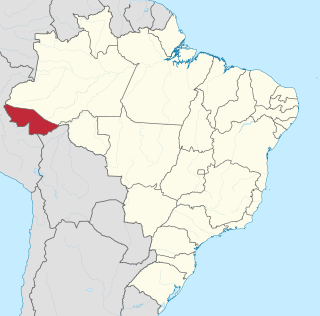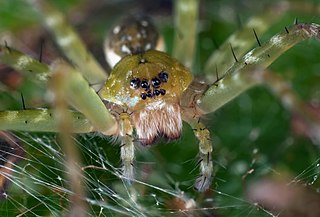
Acre ( ) is a state located in the west of the North Region of Brazil and the Amazonia Legal. Located in the westernmost part of the country, at a two-hour time difference from Brasília, Acre is bordered clockwise by the Brazilian states of Amazonas and Rondônia to the north and east, along with an international border with the Bolivian department of Pando to the southeast, and the Peruvian regions of Madre de Dios, Ucayali and Loreto to the south and west. Its capital and largest city is Rio Branco. Other important places include Cruzeiro do Sul, Sena Madureira, Tarauacá and Feijó. The state, which has 0.42% of the Brazilian population, generates 0.2% of the Brazilian GDP.

Abarema is a neotropical genus in the family Fabaceae. It is native to Brazil, Cuba, and Venezuela. Most of the species can be found in the Amazon Basin and the Guyana Highlands. They have a deep-green fernlike foliage, with bipinnately compound leaves.
Amburana acreana is a species of legume in the family Fabaceae. It is found in Bolivia, Brazil, and Peru. Its main threat is habitat loss.
Hydrochorea acreana is a tree species in the legume family (Fabaceae). It is native to portions of Central and South America, including Nicaragua, Costa Rica, Colombia, Venezuela, Peru, and northern Brazil. Fruiting trees apparently have never been found.
Hydrochorea is a genus of flowering plants in the family Fabaceae. It includes 11 species native to Central and South America and west and west-central Africa. It belongs to the mimosoid clade of the subfamily Caesalpinioideae.

The Acre War, known in Brazil as Acrean Revolution and in Spanish as Guerra del Acre was a border conflict between Bolivia and the First Brazilian Republic over the Acre Region, which was rich in rubber and gold deposits. The conflict had two phases between 1899 and 1903 and ended with an Acrean victory and the subsequent Treaty of Petrópolis, which ceded Acre to Brazil. The outcome also affected territories disputed with Peru.

Napeogenes sylphis is a species of butterfly of the family Nymphalidae. It is found in South America.
Calliini is a tribe of longhorn beetles of the subfamily Lamiinae.

Hemilophini is a tribe of longhorn beetles of the subfamily Lamiinae.
Acreana is a genus of beetles in the family Cerambycidae, containing a single species, Acreana cuprea. It was described by Lane in 1973.
Purusia is a genus of longhorn beetles of the subfamily Lamiinae, containing the following species:
The Manicoré Biological Reserve is a biological reserve in the state of Amazonas, Brazil. It fully protects an intact area of the Amazon rainforest that is rich in biodiversity, and serves as part of a shield against the advance of the arc of deforestation.
The Aripuanã National Forest is a national forest in the state of Amazonas, Brazil. It supports sustainable forestry, and also protects the environment, supports scientific research and protects the sustainable lifestyle of the traditional inhabitants of the forest.
The Cazumbá-Iracema Extractive Reserve is an extractive reserve in the state of Acre, Brazil. The inhabitants extract rubber, Brazil nuts and other products from the forest for their own consumption or for sale, hunt, fish and engage in small-scale farming and animal husbandry. The reserve was created in 2002 as a sustainable use conservation area after a long campaign by the rubber tappers to prevent the government from evicting them and clearing the Amazon rainforest for cattle ranching. The reserve is rich in biodiversity, and helps form a buffer zone for the adjoining Chandless State Park. Due to decreases in rubber prices, some families want to clear the forest to raise cattle, which is seen as more profitable.

Sport Clube Humaitá, commonly referred to as Humaitá, is a Brazilian professional club based in Porto Acre, Acre. They play in the Série D, the fourth tier of Brazilian football, as well as in the Campeonato Acreano, the top flight of the Acre state football league.

Thaumasia is a genus of nursery web spiders that was first described by Josef Anton Maximilian Perty in 1833.
Diospyros inconstans is a species of tree in the family Ebenaceae. It is native to Panama and South America.

Cariblatta is a genus of cockroach in the family Ectobiidae. There are more than 70 described species in Cariblatta.







